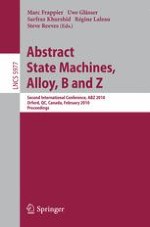2010 | OriginalPaper | Buchkapitel
On an Extensible Rule-Based Prover for Event-B
verfasst von : Issam Maamria, Michael Butler, Andrew Edmunds, Abdolbaghi Rezazadeh
Erschienen in: Abstract State Machines, Alloy, B and Z
Verlag: Springer Berlin Heidelberg
Aktivieren Sie unsere intelligente Suche, um passende Fachinhalte oder Patente zu finden.
Wählen Sie Textabschnitte aus um mit Künstlicher Intelligenz passenden Patente zu finden. powered by
Markieren Sie Textabschnitte, um KI-gestützt weitere passende Inhalte zu finden. powered by
Event-B [1] is a formalism for discrete system modelling. The Rodin platform [2] provides a toolset to carry out specification, refinement and proof in Event-B. The importance of proofs as part of formal modelling cannot be emphasised enough, and as such, it is imperative to provide effective tool support for it. An important aspect of this support is the extensibility of the prover, and more pressingly, how its soundness is preserved while allowing extensibility. Rodin has a limited support for adding rules as this requires (a) a deep understanding of the internal architecture and (b) knowledge of the Java language. Our approach attempts to provide support for user-defined proof rules. We initially focus on supporting rewrite rules to enhance the rewriting capabilities of Rodin. To achieve this objective, we introduce a
theory
construct distinct from contexts and machines. The theory construct provides a platform for the users to define rewrite rules both conditional and unconditional. As part of rule definition, users decide whether the rule is to be applied automatically or interactively. Each defined rule gives rise to proof obligations that serve to verify its conservativity. In this respect, it is required that validity and well-definedness are preserved by rules. After the conservativity of all rules contained in a theory is established, the theory can then be deployed and available to the proving activity. In order to apply rewrite rules, it is necessary to single out applicable rules to any given sequent. This is achieved through a pattern matching mechanism which is implemented as an extension to Rodin. Our approach has two advantages. Firstly, it offers a uniform mechanism to add proof rule without the need to write Java code. Secondly, it provides a means to verify added rules using proof obligations. Our work is still in progress, and research has to be carried out to (a) cover a larger set of rewrite and inference rules, and (b) provide guidelines to help the theory developer with deciding whether a given rule should be applied automatically.
